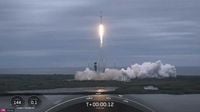SpaceX achieved another milestone in its ongoing mission to expand global internet access by successfully launching its Falcon 9 rocket from Cape Canaveral on Saturday night, April 5, 2025. This latest mission deployed 28 Starlink satellites into low-Earth orbit, marking a significant step forward in the company's efforts to provide high-speed internet to underserved areas worldwide.
The Falcon 9 first stage booster, designated B1078, completed its 19th flight during this mission. After liftoff, the booster landed safely on the Just Read the Instructions (JRTI) droneship stationed in the Atlantic Ocean, demonstrating the reliability and reusability of SpaceX's technology. The Falcon 9 Block 5 booster, which was first utilized for the Crew-6 mission, has now successfully completed 19 launches and landings, showcasing its durability and efficiency.
Weather conditions for the launch were favorable, with a 99% chance of success predicted. The forecast indicated a temperature of 76°F, scattered clouds with 40% cloud cover, and a wind speed of 19 mph. SpaceX officials closely monitored these conditions, particularly focusing on liftoff winds, to ensure a safe launch.
The Starlink satellites launched during this mission are part of SpaceX’s broader initiative to provide high-speed internet access across 125 countries, including remote and disaster-stricken regions. As the demand for reliable internet continues to grow, these low-Earth orbit (LEO) satellites play a crucial role in bridging the digital divide.
Since its inception, the Starlink program has been pivotal in delivering internet services to areas where traditional infrastructure is lacking. With each launch, SpaceX aims to enhance its satellite constellation, ultimately improving connectivity for millions of users around the globe.
As of now, the Falcon 9 booster B1078 has supported a variety of missions, including Crew-6, SES O3b mPOWER-B, USSF-124, and Bluebird 1-5, in addition to its 15 Starlink missions. This versatility highlights the Falcon 9's capability to handle diverse payloads, further solidifying SpaceX's position as a leader in the aerospace industry.
Looking ahead, SpaceX plans to continue its ambitious launch schedule, with numerous missions lined up to expand the Starlink network and enhance its operational capabilities. The company remains committed to its goal of providing fast, reliable internet access to every corner of the globe.
In conclusion, the successful launch of the Falcon 9 rocket on April 5, 2025, not only demonstrates SpaceX's technological prowess but also underscores the importance of expanding internet access to underserved populations. As the world becomes increasingly interconnected, initiatives like Starlink are essential in ensuring that no one is left behind in the digital age.






